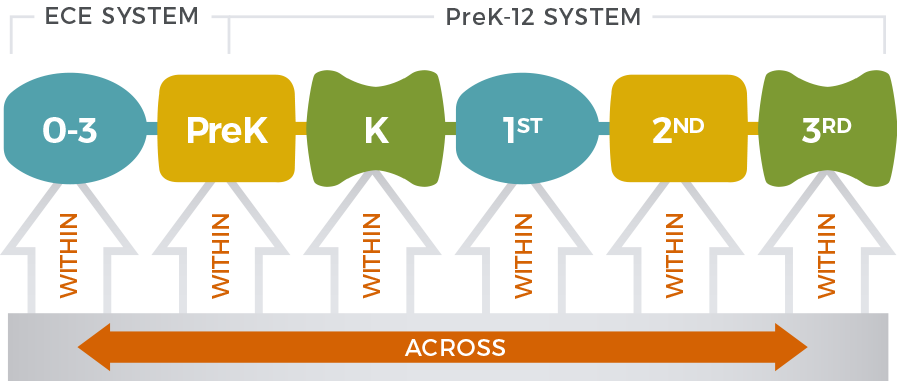About P-3
What is P-3?
The vision for P-3 is to improve the quality and coherence of children’s learning opportunities, from the experiences children have in early learning (including PreK, Head Start, child care, and other early learning opportunities before — or “pre” — formal entry into school) and extending through elementary school. At the Center, P-3 signifies both an age range and a lens for thinking about organization and system level change.
At the Center, we use the following definitions and boundaries for our P-3 work:
- P-3 encompasses the range of children’s learning experiences from birth (Pre-school) through 3rd grade.
- On this site, “PreK-3rd Grade” is used interchangeably with “P-3”. Both terms reflect the importance of aligning across ECE and K-12 classrooms and systems. As a Center, we prefer “P-3” as it is more inclusive of the full ECE mixed delivery system (not just school-based PreK programs).
- P-3 is not a rigid, replicable, singular model. States, communities, and groups of organizations implement P-3 “approaches” that are uniquely tailored to their contexts.
- P-3 approaches are not a mixed bag of initiatives or programs. They require intentional planning, formally designed strategies, and explicit leadership and support.
- P-3 focuses on the educational experiences of children in the ECE and PreK-12 systems. As a Center, we are not focused on other types of organizations and systems children and families navigate during this age range, like health care and child welfare.
- Often, ECE and PreK stakeholders lead P-3 work. While their engagement is critical, we believe more traditional K-12 stakeholders (e.g., elementary principals, district central office administrators, state education agencies) are also essential partners in this work.
Why Focus on P-3?
Research shows that the brain develops rapidly and expansively during early childhood, and as a result, foundational learning and development occurs during this period. Early experiences shape brain development and vast disparities exist in young children’s experiences, in terms of their opportunities and outcomes. Research shows that achievement gaps exist by the time children enter Kindergarten and do not change substantively by 3rd grade. The Center’s work is rooted in better understanding and actively addressing the disconnects between organizations and systems that contribute to opportunity and achievement gaps across the P-3 continuum.
By definition, P-3 encompasses both the ECE mixed delivery system and the PreK-12 system. These systems have differing values, vocabularies, visions, professional standards, governance, and funding streams. The Center focuses on comprehensive P-3 approaches. These are improvement efforts within and across ECE and PreK-12 to improve each age/grade level and align across them, ensuring that children experience high-quality learning year after year.

